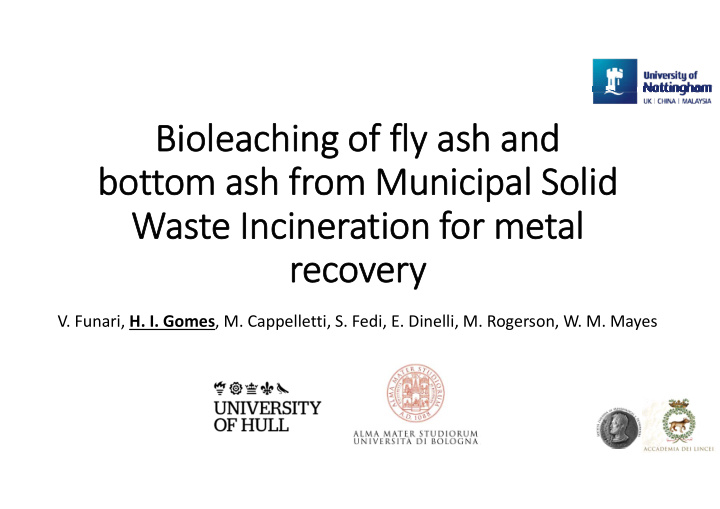



Bi Biol oleachi eaching of of fly fly ash ash and and bot bottom om ash ash fr from om Muni Munici cipal pal Solid lid Wa Waste In Incin cineratio tion fo for met metal re reco cove very V. Funari, H. I. Gomes , M. Cappelletti, S. Fedi, E. Dinelli, M. Rogerson, W. M. Mayes
Potential for metal recovery Market Price Major elements output in tons per year Euro per kilograms Transfer Coefficients Funari et al. (2015). Waste Management, 45: 206 ‐ 216
Market Price Trace elements output in kilograms per year Euro per kilograms Transfer Coefficients Funari et al. (2015). Waste Management, 45: 206 ‐ 216
Bio what? http://www.mintek.co.za/ https://goo.gl/sZyuRe
Objectives • How to transform BAs and FAs into a low grade urban mine? • Bioleaching applied to MSWI residues • Start ‐ point optimisation • Metal recovery? http://www.ceh.com.sg/
Acidophilic mixed culture Enriched from sulphidic ore mines Libiola ore deposit Cu Funari et al. (in progress) At. ferrooxidans Acidithiobacillus sp. Acidovarax sp. Delftia acidovorans Chlorobium limicola Actinobacteria Proteobacteria Thermophilic bacillus sp.
biofilm + nutrients (shake flasks) 2.50 2.00 Activation 1.50 pH 1.00 0.50 0.00 15/05/2016 20/05/2016 25/05/2016 30/05/2016 04/06/2016 Time Manual pH adjusting 1% pulp density pH 2.2 Precultivation / adaptation pH 3 5% pulp density 10% pulp density pH 3 2 L reactor Bioleaching optimisation ≠ Fe II Ion exchange resins for metal recovery ≠ S 0 ≠ pH (3 vs 6)
Optimisation With or without Fe II Pulp density, rot. speed, T SAME Inoculum SAME Elemental sulphur SAME Iron sulphate heptahydrate DIFFERENT 100 Bottom ash 90 setpoint pH 3 80 70 60 R % 22 g/L iron(III) 50 0 g/L iron(III) 40 30 20 10 0 Pb Al Cr Cu Zn Co Sn
Optimisation with 5 or 10 g L ‐ 1 S 0 Pulp density, rot. speed, T SAME Inoculum SAME Elemental sulphur DIFFERENT Iron sulphate heptahydrate SAME 100 Fly ash 90 setpoint pH 3 80 70 60 R % 50 5g/L sulphur 40 10g/L sulphur 30 20 10 0 Al Cr Cu Zn Co Sn Pb
Optimisation pH set point Pulp density, rot. speed, T SAME Inoculum DIFFERENT Elemental sulphur SAME Iron sulphate heptahydrate SAME 100 Fly ash 90 setpoint pH 6 80 70 60 R % acidophilic 50 acidophilic + alkalinophilic 40 30 20 10 0 Pb Al Cr Cu Zn Co Sn
Metal Recovery CHELEX vs. AMBERLITE 10 9 Metal Recovery % CHELEX 8 7 AMBERLITE 6 5 4 3 BA sample 2 10% pulp density 1 one ‐ step bioleaching 0 Al Co Cr Cu Pb Zn + batch test for metal recovery 70 (from the bioleachate) 60 CHELEX Metal Recovery % 50 AMBERLITE 40 30 20 10 0 Sb Pr Gd Ho Er
Process design 1M H 2 SO 4 solution in 7 days using: 10 g/L S 0 4.2 g/L other salts
Ta Take hom home messag ssages • Recovery is challenging – market can be an obstacle • Bioleaching can remove metals from fly ash and bottom ash • Further research needed for isolate metals helena.gomes@nottingham.ac.uk @HelenaIGomes
Recommend
More recommend